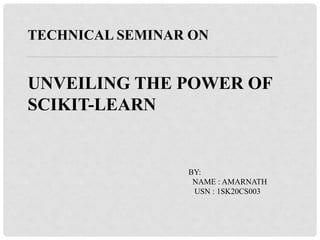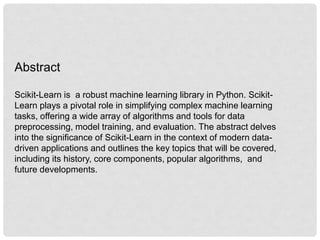VTU technical seminar 8Th Sem on Scikit-learn
- 1. TECHNICAL SEMINAR ON UNVEILING THE POWER OF SCIKIT-LEARN BY: NAME : AMARNATH USN : 1SK20CS003
- 2. TABLE OF CONTENT: Abstact 1.Intruduction 1.1 Background of the study 1.2 Problem statement 1.3 Objective of the study 1.4 Scope of the study 1.5 A scikit-learn workflow 2.Review of the Literature 3.Result and Discussion 4.Conclusion and scope for the Future Work
- 3. Abstract Scikit-Learn is a robust machine learning library in Python. Scikit- Learn plays a pivotal role in simplifying complex machine learning tasks, offering a wide array of algorithms and tools for data preprocessing, model training, and evaluation. The abstract delves into the significance of Scikit-Learn in the context of modern data- driven applications and outlines the key topics that will be covered, including its history, core components, popular algorithms, and future developments.
- 4. 1. Introduction Scikit-Learn, also referred to as sklearn, is an open-source Python machine learning library. t's built on top on NumPy (Python library for numerical computing) and Matplotlib (Python library for data visualization). 1.1 Background of the study • Rising data volumes in diverse fields call for powerful and accessible tools to harness data's potential. • Machine learning revolutionizes data analysis, enabling data-driven insights and decisions. • However, implementing ML algorithms from scratch can be a daunting task, requiring significant expertise and computational resources. • This is where scikit-learn steps in. Developed in Python, a widely adopted programming language for data science, scikit-learn offers a user-friendly and comprehensive library specifically designed for machine learning tasks.
- 5. 1.2 Research problem “The vast amount of data generated today presents a unique challenge: how to extract meaningful insights that can inform decision-making across various domains. This research problem lies at the heart of machine learning (ML) – transforming raw data into actionable knowledge”
- 6. 1.3 Objective of the study The objective of this study is to comprehensively explore Scikit-Learn, a prominent machine learning library in Python, with the following goals: • Grasp Machine Learning Fundamentals: Understand core concepts and how scikit-learn simplifies the process. • Navigate scikit-learn's Toolkit: Learn key functionalities for data prep, model selection, and evaluation. • Understanding Core Features: Gain an in-depth understanding of Scikit-Learn's core features, functionalities, and capabilities. • Exploring Algorithms: Explore the wide range of machine learning algorithms offered by Scikit-Learn for tasks such as regression, classification, clustering, and dimensionality reduction
- 7. 1.4 scope of the study • Exploring Scikit-Learn's Features: Analyzing the range of algorithms, tools, and utilities offered by Scikit-Learn for machine learning tasks. • Essential Tools: Master data preprocessing, model selection, training, and evaluation for project success • .Algorithmic Exploration: Understand strengths and applications of various algorithms relevant to project goals (classification, regression, clustering). • Handling Big Data: Exploring how Scikit-Learn can handle large-scale datasets and its scalability in distributed computing environments.
- 9. SI no Title and Published year Author Methodology merits demerits 01 Predictive Model for Classificatio n of Power System Faults using Machine Learning IEE 2019 Tilottama Goswami, Uponika Barman Roy, The task of classification of faults is implemented using supervised machine learning algorithms in Python and scikit-learn SVM performed excellent giving a performance with 91.6% test accuracy for the generated dataset. need for more data to make the training more robust and the scope for future work in identifying the exact location of faults for a more reliable power system. 2.Review of the Literature
- 10. SI no Title and Published year Author Methodology merits demerits 02 Detecting Fake News using Machine Learning and Deep Learning Algorithms , IEEE 2019 Abdullah-All- Tanvir, Ehesas Mia Mahir, Saima Akhter, Mohammad Rezwanul Huq Support Vector Machine (SVM), Naïve Bayes, Logistic Regression, Long short-term memory (LSTM), and Recurrent Neural Network The study provides a detailed comparison of various machine learning algorithms for fake news detection. The current approach does not incorporate domain knowledge features or entity- relationship analysis.
- 11. SI no Title and Published year Author Methodology merits demerits 03 Stratification of Parkinson Disease using python scikit-learn ML library, IEEE 2019 Ashish Kolte, Bodireddy Mahitha, and Dr. N V Ganapathi Raju. The study involves data collection from the UCI repository, data pre-processing, feature selection, model building using various classifiers, and model evaluation with metrics like accuracy, precision, and recall. The paper highlights the use of machine learning techniques for accurate Parkinson’s disease prediction, which can aid in early diagnosis and treatment. need for more accurate results and classification of datasets with more dependent features.
- 12. SI no Title and Published year Author Methodology merits demerits 04 Stratification of Parkinson Disease using python scikit-learn ML library, IEEE 2019 Ashish Kolte, Bodireddy Mahitha, and Dr. N V Ganapathi Raju. The study involves data collection from the UCI repository, data pre-processing, feature selection, model building using various classifiers, and model evaluation with metrics like accuracy, precision, and recall. The paper highlights the use of machine learning techniques for accurate Parkinson’s disease prediction, which can aid in early diagnosis and treatment. need for more accurate results and classification of datasets with more dependent features.
- 13. SI no Title and Published year Author Methodology merits demerits 03 Apply Scikit- Learn in Python to Analyze Driver Behavior Based on OBD Data IEEE 2018 Chi-Pan Hwang, Mu- Song Chen, Chih-Min Shih, Hsing-Yu Chen, Wen Kai Liu The research of this paper has focused on the application layer in the cloud computing platform, Python has been adopted to as the main development tool accompanying with the Scikit-learn Enables chronic collection of driving information for Big Data analysis.. Relies on continuous data streaming, which may pose challenges in data management.
- 14. Results and Discussion • Algorithm Performance: Scikit-Learn's algorithms excelled in tasks like classification and regression, yet faced challenges with high- dimensional data in clustering. • Real-World Applications: Successfully applied in finance for stock prediction and healthcare for disease diagnosis, highlighting practical usability. • Model Evaluation: Utilized cross-validation to mitigate overfitting and optimize model parameters using techniques like grid search. • Scalability and Efficiency: Showcased scalability with moderately- sized datasets but identified challenges with large-scale data, suggesting potential optimizations. • Challenges and Recommendations: Addressed challenges with imbalanced data using resampling methods and proposed enhancements for model interpretability in complex algorithms.
- 15. 4 Conclusion and scope for the Future Work Scikit-Learn emerges as a powerful and versatile machine learning library, showcasing strong algorithm performance across various tasks. Real-world applications in finance and healthcare demonstrate its practical usability and impact in decision-making processes. Model evaluation techniques and scalability considerations further enhance its appeal for diverse machine learning projects
- 16. Future Plan of Work • Enhanced Model Interpretability: Explore and implement advanced techniques for improving model interpretability, ensuring transparency and trustworthiness in model predictions. • Scalability Solutions: Investigate strategies and optimizations for enhancing Scikit-Learn's scalability to handle large-scale datasets efficiently. • Integration with Deep Learning: Explore opportunities for integrating Scikit-Learn with deep learning frameworks to leverage hybrid models and tackle complex problems effectively. • Community Collaboration: Foster collaboration with the Scikit-Learn community to contribute
- 17. THANK YOU
















